
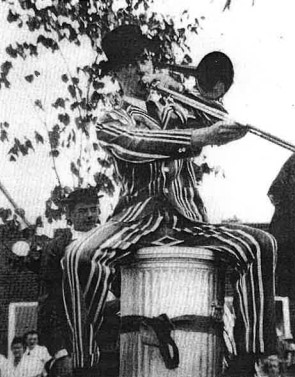
Spike Jones superfan and Cartoon Editor Extraordinaire: Skip Craig
Jay Ward Productions was full of artists, writers, and technicians who defined the style of the studio. Besides Ward himself, there was also Alex Anderson, Chris Hayward, Allan Burns, Lloyd Turner, Bill Scott, Bill Hurtz, Gerard Baldwin, Sam Clayberger, Don Jurwich, and dozens of others. Among the most significant was also my friend Skip Craig who passed on Monday March 31, 2025. He made the announcement on Friday April 4. I interviewed Skip and his son Jeff here.
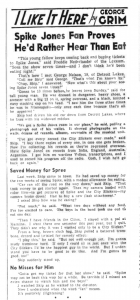
THE ARTICLE THAT GOT SKIP THE JOB. Skip was mistaken for George Nelson rather than George Craig. We’re not entirely sure why. (click to enlarge)
It was in high school where Skip Craig became the ultimate Spike Jones fan. Spike Jones’s City Slicker Band was among the most popular in America during the 1940s and 1950s. In my interview with Skip, he discussed fulfilling his dream of working with Spike:
“In high school (Grad June 1949), I was a Spike Jones fanatic. I collected his records and went to the show whenever it was in the area. In March of 1950, they had a cancellation in Chicago and came to Minneapolis every day for two weeks. So, I went down the first night and then hung around and went to every show. The local human interest columnist on the Minneapolis Tribune got ahold of me for an interview. I said it in that “if I could just get to sit in with the band, that would be incredible.” Once in a while, the band would use guest celebrities. Dick Tracy’s Chester Gould was one. They gave him a funny suit and a prop horn and sat him in the back row to fake play for a show. Later, he reciprocated and Spike and the entire band were in the strip for a couple of weeks.

Spike Jones and Joe Siracusa signed this for Skip while Skip went on tour as the “groupie” for Spike’s band.
A couple of nights later, Spike sent his valet out in the audience and took me back to his dressing room, pointed at me, and said, “You’re in the show Sunday afternoon and evening.” So that’s how I got acquainted with Spike and the guys in the band. That was March 26, 1950. So a couple of months later, I had my horn painted and a slicker suit made. A lady at Penny’s put that together for me. I also had a derby. On May 30th, I met the train in Fargo (the show traveled in two Pullmans and a baggage car) and Spike seemed to dig it and again said “You’re in the show tonight.” My now wife was in college across the river, and got to see me play. I got to know both Joe Siracusa and Joe Colvin (trombone) well, and corresponded that summer with both. Three weeks after that show, the Korean War started and I knew where I’d end up – and I did, thanks to the draft. So when Colvin said in a letter, “Maybe you should come out.”, I knew it was now or never!
I had been working at Swift’s locally and saved up a few hundred bucks, and in the fall of 1950, I headed to Hollywood. Joe Colvin got me a room in a boarding house he used to be in. I had the sleeping porch for five bucks a week. I would take the red-car to Beverly Hills and hang around the office. There I would chase coffee and hang around. Spike had me come in one evening where they were planning the record of Tennessee Waltz and I Haven’t Been Home in Three Whole Nights, and to chase coffee for everybody. Spike tore a five-dollar bill in half, and said, “come back tomorrow, and I’ll give you the rest of it.” I then said, “I would’ve paid you just to be here.” I got to go to the RCA recording studio to see them record Tennessee Waltz and Three Whole Nights and chase coffee for them. One other highlight was the Santa Claus Lane Parade of Stars. The band marched in their ‘union’ suits, long john’s, derbies, and ear muffs, playing Christmas songs. I went down to inflate balloons, and ended up marching down Hollywood Blvd. with the bass drum on my back steering Dick Morgan who couldn’t see where he was going. Now so we’re getting towards Christmas of 1950, and I went home.

Skip and his wife Helen in an article promoting Skip’s time at UPA.
They called me and said, “You’re hired. The tour leaves January 6th.” I had a great year and a half selling programs, working wardrobe, did bits in the audience, and once in a while, I’d just sit in the back row. As a band boy, I also packed and unpacked the instrument case, worked wardrobe, hung and repacked wardrobe case, shined button shoes, set up and struck Spike’s drums, and dipped Juggler Bill Kings’ torches and head pieces while he was on. But along the third tour, I heard from the draft board. I got my physical in Milwaukee while on tour and had to quit the summer of ‘52. I went home and would soon end up in Korea, just like I knew I would. So that’s my story with Spike. I was just a complete fanatic about anything Spike Jones. I loved that Slicker sound. In fact, he designated me in an autograph as the no. 1 City Slicker Fan.”
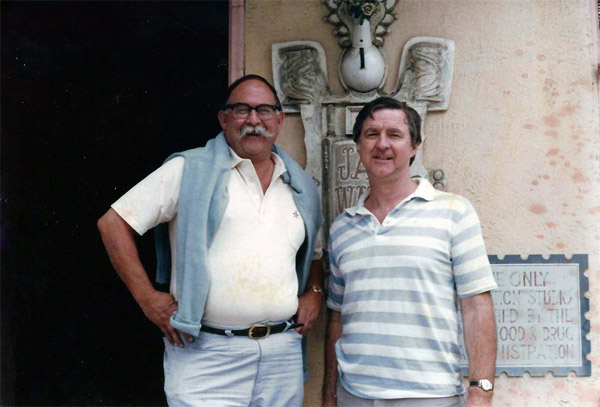
Jay Ward and Skip Craig
It was Joe Siracusa who brought Skip to animation. Siracusa was Spike’s drummer who left drumming and came to UPA as an editor. He brought many of the talent in Spike’s band to the animation editing rooms. Skip came to UPA in 1955 when The Boing Boing Show was in production.
Skip would then become an integral part of Jay Ward Productions. Skip’s first work for Jay was freelance. However, he would soon become a key member of the studio and would remain there until it closed. One of the most memorable events from his time at Ward was when he was sent to Minnesota to buy a Mooselvanian island. Here is that story:
“Yeah, that was in the midst of that Operation Loudmouth publicity campaign. Jay came around one day and said, “you’re going to Minnesota to buy an island.” I said okay because you never knew if he was serious or not because he was so quirky. He said then “I’m gonna give you a signed blank check, so don’t get across the Canadian border and keep going.” Publicity man, Howard Brandy, was dressed as Dudley Do-Right, and he was dressed like Napoleon. He bought this Panel Truck, and he got Sam Clayberger to create this paper mache art decorations for it. They made it into a campaign truck with a bandwagon and a blasting loud speaker on top. They went across the country and had these Statehood for Mooselvania parties and signings of petitions. The truck worked its way around the country with Jay getting kicked out of several towns as nuisances because of Jay always blaring his music and driving up and down the main street. They got a big bunch of signed petitions and ended up at the white house gate.
In the meantime, I was up in Minnesota and the Lake of the Woods. I come from a little town called Detroit Lakes, and I got my uncle, who was a retired mailman there and had also done some surveying. We took off and drove to the Canadian border. He knew enough to go into the courthouse and look at all the plots and maps. It turned out that there were hundreds of islands on the Canadian side and like five or seven on the American side. We ended up finding one guy who was a dentist in one of the towns up there. He was a hip guy and saw the fun in it. He said, “I’m not gonna sell it because I am building a little fishing shack out there, but I’ll lease it to you to use for publicity purposes.” So I got a three-year lease on the thing. We then flew out to Mooselvania in an old one engine plane with pontoons.
When we got to the island, the pilot said “boy, I hope the weather doesn’t blow up, I’ve gotten stuck out here.” But he kept circling and going over the mainland for a while so he could find a moose to show us. He finally found one and said, “there, there’s Bullwinkle.” We spent a little time out there, and the island was small. I don’t think it was more than three acres. It had a swampy section and a hilly section. We look a lot of pictures. Jay loved it when we all got back.
In the meantime, Howard and Jay cruising the country, getting these petitions signed. They had quite a pile of them. Then when they get to Washington DC, they drive up to the gate to the White House. The guard at the gate has his hand on his gun and tells Jay to get out of here. Howard is cowering in the back hiding. And Jay says, “Well, he doesn’t have to be rude.” This was the day of the very height of the Cuban Missile Crisis, and here are these two nuts at the gate demanding to see the president to present their statehood petitions. This is another example of Jay’s great timing.”
Skip ended his career at Walt Disney Television Animation, where he worked until retirement in 2012.

Skip Craig and Spike Jones’s alumni Roger Donley’s credits on Fractured Flickers. More than any other series, Jay Ward relied heavily on Skip’s editing talents. It was editing that made the series so well produced.
Despite never meeting in person and knowing plenty of others in the animation field, it’s fair to say that Skip Craig was the closest friend I had in the cartoon industry. In mid-2020, I was researching on what my next Cartoon Research article would be about. After rereading Darrell Van Citters’ The Art of Jay Ward Productions, I considered writing an article on one of non-artists or writers that the studio consisted of, and I remembered Skip’s name both in Darrell’s book and Keith Scott’s The Moose that Roared. Not knowing how to reach him, I discovered his granddaughter Erika on social media and reached out to her. She promptly responded with enthusiasm and got me in contact with her son Jeff and her grandad Skip. After that, I decided that Jeff should also be involved with the call. I’ve interviewed well over two hundred people over the years, and I record every one of them. Because of Skip’s hearing, it was harder to interview him properly with my phone away from my face so that I could record what he and I were both saying. Jeff stepped in to help strengthen the conversation this way and to add a new perspective that wasn’t simply rehashing all that Skip said in The Moose that Roared.
The interview I conducted was as a success and remains my all-time favorite post I’ve done for this blog. Besides Skip and Jeff, Jeff’s lovely wife Christine listened in the background serving as a delightful audience to our discussion. The conversation was also a favorite of Skip’s and for the next two months we provided handwritten notes back and forth to better the interview. Without the internet at Skip’s home, this made Jeff’s contribution even more valuable. He brought back revised editions of the article to Skip every time. The final result was fantastic, and Skip kept a printed copy of the article with him and referenced it frequently to remind himself of his fantastic career. Besides my own article, he also had a printed copy of Harry McCracken’s article on the history of the Bullwinkle statue, which he also really enjoyed. I got Jeff to get him a copy, and the next day Skip called me, enthused with the article.

Jeff and his dad.
Afterwards Skip and I kept in touch. And we would talk frequently. Sometimes monthly, sometimes even weekly. I think that Skip admired me for being young and passionate about what he was passionate about. As devoted fans of Old Time Radio, we were constantly gossiping about radio stars as well as about our favorite Spike Jones songs. We also discussed politics, comic books, silent movies, and of course animation.
Before closing, a few of Skip’s longtime friends, collaborators, and fans have offered their tributes to this article:

Skip Craig and Amber Jones
Amber Jones writes:
“I was first introduced to Skip when I began working on a project about Bill Scott in 2020. He told me so much information and stories about Bill and gave me so many interviews for it, I had lots of material to use and he was super helpful.
We then met in person for the first and only time a few years later. Skip was an amazing man who did so much for so many people. We will never see someone of his kind again, with a legacy as big as his. Rest easy my friend.”

Ted Hering (who along with Skip wrote Spike Jones’s discography for The Man Who Murdered Music).
I met Skip Craig at a Spike Jones stage show at Disneyland in 1964.
My friend Warren Dexter and I were sitting in the front row, and Skip, right next to us, asked us to save his seat so he could go backstage and see his old friend Spike!
This, of course, let to a nice conversation and the exchange of phone numbers for contacts that would last until his death 60 years later.
 I think all Spike Jones fans have interest in classic animation. Spike’s music could be described as a cartoon for the ears.
I think all Spike Jones fans have interest in classic animation. Spike’s music could be described as a cartoon for the ears.
Skip was rich in his knowledge of character voices.
And, of course, there were some personalities who were cartoon voice stars that also worked with Spike. Paul Frees is probably the best example. Paul appeared on Spike’s records for 12 years, beginning with his Peter Lorre imitation on “My Old Flame.”
Thurl Ravenscroft — bass singer with Spike, and the voice of Tony the Tiger — was the narrator one Christmas eve at Skip’s church. So, of course, Skip invited me. What a memory!
June Foray had two minor encounters with Spike’s band. One: she was reportedly the voice of the parrot in the “Chloe” production number in the movie “Bring On the Girls.” Two: she auditioned for the part of Olive Oyl on Spike’s record of “I’m Popeye the Sailor Man.” (This is one of the few rolls she didn’t win. She sounded lot like Little Blue Riding Hood singing “He’s Popeye the Sailor Man.”)
Skip maintained friendship with several band members from his Spike Jones days. Drummer Joe Siracusa and comic vocalist Earl “Sir Frederic Gas” Bennett both worked as film editors with UPA Studio, and later Hanna-Barbera. Tuba player Roger Donley actually worked side by side with Skip at Jay Ward’s! Roger kept a prop skunk right there in their work room as a souvenir.

Skip and George Wayne of the Wayne and Marlin Trio.
As far as Skip’s helping me in my pursuit of Spike Jones material, I had almost all of Spike’s records at the time we met. But Skip introduced me to collectable items I didn’t even know existed, like Standard Radio Transcriptions! (I had known of one or two V-Discs, but he had the whole collection.)
After Spike died, it was Skip who was shown Spike’s archives of radio shows by his manager, Peter James. Skip was not the slightest bit possessive, but called me right away to come and examine the material with him.
I’ve read some of the other tributes to Skip that mention his hours on the phone with them, discussing leads to animation and music collectables, the history of various animation projects, and Spike Jones conversations. I certainly had my share of phone time with Skip! He would talk for half an hour or more. Even in his last phone call with me in January, he was still telling funny stories of his days with the band. (He was carrying the bass drum in a parade, ahead of banjo player Dick Morgan. Unfortunately, there was a horse in the parade right ahead of them. Skip was trying desperately to avoid the droppings the horse left on the street. But, alas, he and Dick stepped right in them!)
Skip was one of those who never had a mean word about anyone. He obviously took delight in encouraging others in their hobbies and interests.
 Jordan R. Young (Author of Spike Jones Off the Record: The Man Who Murdered Music)
Jordan R. Young (Author of Spike Jones Off the Record: The Man Who Murdered Music)
Skip Craig was a friend for over 40 years and a key resource for my book on comedy bandleader Spike Jones and his City Slickers. I met him through Spike’s drummer, Joe Siracusa, who jumpstarted Skip’s career as an editor by making him part of his team in the editing room at UPA after Joe left the band. Spike Jones himself called Skip “Number One City Slicker Fan.” One of his most prized possessions was a complete mint set of Spike’s RCA recordings, untouched by a phonograph needle.
Skip contributed a wealth of photos and information for my book, along with copies of rare recordings. He started collecting arcane discographical info on the band in the ‘40s but was so modest he tried to dissuade me from giving him co-credit (with Ted Hering) on the discography for my book. We both felt he deserved it.
He was an extraordinarily generous guy who would literally give you the shirt off his back. He never tired of telling the story of comedian Doodles Weaver so admiring his red-and-white football jersey backstage after a show one night, Skip made a gift of it to the comic and went home shirtless 200 miles.

Skip Craig and Spike Jones
John Teftteller (Vintage radio buff and man behind World’s Rarest Records online):
“I first met Skip at his day job as an editor at Jay Ward Productions in Hollywood where he was chief editor of “Fractured Flickers” as well as “Rocky and Bullwinkle” cartoons among others.
Mr. Craig and I shared the love of vintage 30s, 40s and 50s radio programs and he was one of the pioneer collectors of that material.
He started out as a teenager with Spike Jones and His City Slickers.
MY biggest memory of Skip was how nice and generous he was with younger collectors. Always willing to share from his collection and always EXCITED when “new” transcription discs were discovered.
Thank you, Skip, for all you contributed to the preservation of vintage radio shows. You truly were one of the really GOOD guys!
I can only wish that, somehow, those lost “I Love A Mystery” shows turn up before I join you in the hereafter. I’m so sorry I couldn’t find them while you were still with us. R.I.P. old friend!”
And finally, Keith Scott remembers Skip here:
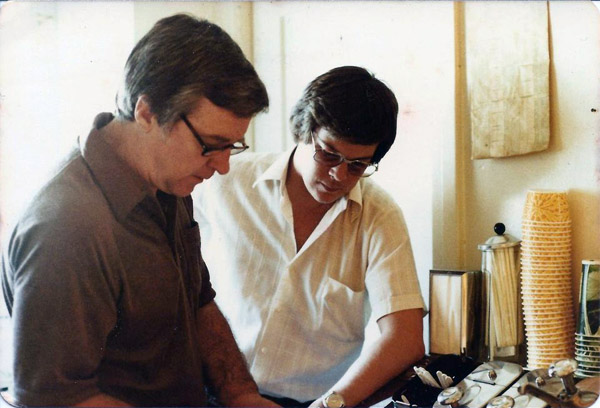
Keith Scott (right) and Skip Craig (left)
MEMORIES OF SKIP CRAIG, by Keith Scott 5 April 2025
“Thanks for this opportunity, Kamden. Skip Craig was indeed one of my closest American friends. I met him when I won a trip to Hollywood in 1973. As a 19-year old Australian voice wannabe, I was (I fancied) the world’s most ardent fan of Jay Ward Productions and its TV output…I’d already written snail mail to Daws Butler, Bill Scott, Paul Frees, William Conrad and June Foray, while back in Sydney my first boss in the business was Bill Hanna who had set up an Aussie wing of H-B in 1972. Mr. Hanna even okayed my first voice-over gig when I was eighteen!
Day one of my LA visit, I dropped into Jay Ward’s Dudley Do-Right store where I met Mrs Ward, and when I mentioned I would like to buy some cassette tapes (“huh??? What are they???”) of old radio shows – prominently displayed in the shop – she sensed that this Australian cartoon-movie geek knew more than the normal customer, so she directed me next door, explaining that the radio tapes were made by Skip Craig. I told her that I knew his name from the credits of Jay’s cartoons, and she laughed and said, “Oh boy, you two will get on just great!!”
 Within a few minutes of talking to the soft-spoken, modest and plain super nice guy Skip, we sure did get on. As a brash young kid, I did my imitation of a recent Quisp-Quake commercial and to my amazement Skip said, “Do those voices again. I want to listen closely to them.” And he then told me that my obvious love of Jay Ward cartoons was just like his insane love of Spike Jones when he too was a teenager. After I told him I collected all the Spike Jones records in Australia he showed me his huge phone book-size catalog of Spike Jones material and I knew I was a mere collecting novice. When he heard more of my voices and learned of my love of Frees, Conrad and all Jay’s other voice artists he graciously offered to give me some free radio shows, introducing me to The Mel Blanc Show, The Stan Freberg Show, Gunsmoke and Escape, a wonderful drama featuring Jay’s cartoon actors. He told me to drop by again in a couple of days…little did I suspect just how generous Skip was, because upon my return he gave me seven reels of FREE shows he had made specially for me , with twenty eight hours’ worth of stuff, including a roll of (for my ears only) outtakes from Jay Ward’s two recent recording sessions.
Within a few minutes of talking to the soft-spoken, modest and plain super nice guy Skip, we sure did get on. As a brash young kid, I did my imitation of a recent Quisp-Quake commercial and to my amazement Skip said, “Do those voices again. I want to listen closely to them.” And he then told me that my obvious love of Jay Ward cartoons was just like his insane love of Spike Jones when he too was a teenager. After I told him I collected all the Spike Jones records in Australia he showed me his huge phone book-size catalog of Spike Jones material and I knew I was a mere collecting novice. When he heard more of my voices and learned of my love of Frees, Conrad and all Jay’s other voice artists he graciously offered to give me some free radio shows, introducing me to The Mel Blanc Show, The Stan Freberg Show, Gunsmoke and Escape, a wonderful drama featuring Jay’s cartoon actors. He told me to drop by again in a couple of days…little did I suspect just how generous Skip was, because upon my return he gave me seven reels of FREE shows he had made specially for me , with twenty eight hours’ worth of stuff, including a roll of (for my ears only) outtakes from Jay Ward’s two recent recording sessions.
From that initial one hour I spent with this most kind-hearted man, a lifelong friendship was formed, one that lasted from 1973 until my final phone call with him in 2023 – wow, half a century – when I heard that his son Jeff had gifted him my new book CARTOON VOICES OF THE GOLDEN AGE. I called him from Sydney and he sounded just as he did when I first knew him. (He was a terrific help when I was writing my first book The Moose That Roared.)
I will sure miss Skip and all the many trips I made from down under to Hollywood in all those years, and I might close this small tribute by saying that after I’d known him for three years I was in a Sydney bookstore and found a brand new old-time radio encyclopedia, the marvellous TUNE IN YESTERDAY by the late John Dunning. The book’s dedication read simply, “To Skip, who knows about friendship and old-time radio.” Sure enough, it was Skip Craig he was talking about.
He didn’t have to give time to a raw kid from another land…but he did so in spades, and that exemplified the type of person he was.
I look back now at just how truly blessed I was as a constant Hollywood visitor in knowing the two kindest, most generous and helpful people in all of the animation biz, Daws Butler and Skip Craig. Farewell, Skipper (Jay’s nickname for him) – you will always be tops in my memory!! My deepest condolences to Helen, Jeff and all the Craig family. RIP”


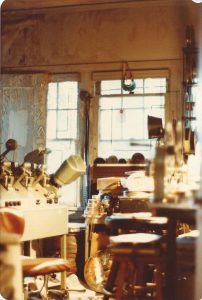





![Verge3D 4.10 Brings 360° Panoramas and macOS Installer [$]](https://som2nynetwork.com/wp-content/plugins/phastpress/phast.php/c2VydmljZT1pbWFnZXMmc3JjPWh0dHBzJTNBJTJGJTJGc29tMm55bmV0d29yay5jb20lMkZ3cC1jb250ZW50JTJGdXBsb2FkcyUyRjIwMjUlMkYwNyUyRmJuYXRpb25fYmFubmVyLTMzNngyMjAuanBnJmNhY2hlTWFya2VyPTE3NTMyODA5NDctMjI1MDQmdG9rZW49Njc3MWRhN2UxYmFlYWU1OA.q.jpg)